Blue hydrogen setback | Europe's largest blue ammonia project in limbo after CCS partner Equinor pulls out
Planned undersea carbon storage facility left without an operator, leaving no clear path forward for EU-subsidised Barents Blue

Planned undersea carbon storage facility left without an operator, leaving no clear path forward for EU-subsidised Barents Blue
